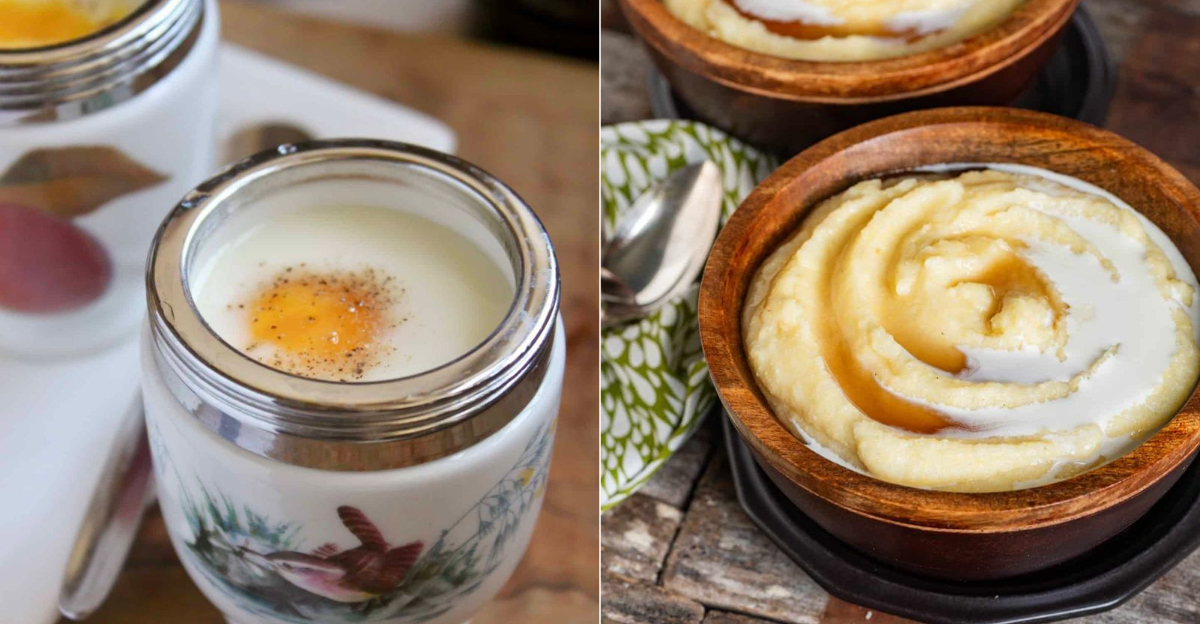20 Old-School Breakfast Dishes That Vanished From Our Plates

Remember when breakfast tables were laden with dishes that took time, love, and tradition to prepare? Before our rushed mornings of granola bars and coffee-to-go, families gathered around hearty morning meals that have slowly disappeared from our daily routines.
These forgotten breakfast classics once defined American mornings but have gradually slipped from our modern menus, replaced by convenience foods and changing tastes.
1. Creamed Chipped Beef on Toast
Affectionately nicknamed “S.O.S” (Stuff On a Shingle) by military veterans, this hearty breakfast was a post-WWII staple. Dried beef simmered in creamy white sauce poured over buttered toast kept bellies full for hours.
My grandfather, a Navy man, would whip this up on Sunday mornings, claiming it kept him going through double watches in the Pacific.
Its high sodium content and time-consuming preparation have relegated it to nostalgia status in most households.
2. Soft-Boiled Eggs in Egg Cups
Once the sophisticated way to start your day, soft-boiled eggs served in decorative egg cups with toast soldiers for dipping have largely vanished from American tables. The delicate timing required—exactly 4 minutes for that perfect runny yolk—demands attention most modern schedules can’t accommodate.
The charming ritual of tapping the shell, slicing the top, and dipping those perfectly cut toast strips has been replaced by scrambled eggs in a hurry or grab-and-go breakfast sandwiches.
3. Griddlecakes with Maple Syrup
Not to be confused with pancakes, traditional griddlecakes were thinner, often sourdough-based, and cooked on cast iron. These delicate rounds required a practiced flip of the wrist and careful temperature control—skills passed down through generations.
Growing up, my grandmother would rise at dawn to feed the sourdough starter before mixing her famous griddlecake batter. The tangy cakes, swimming in real maple syrup, made Monday mornings bearable.
Today’s boxed pancake mixes and electric griddles have largely replaced this morning ritual.
4. Broiled Grapefruit
Half a grapefruit, sprinkled with brown sugar and broiled until caramelized, was once the sophisticated start to breakfast. This bright, warm citrus treat balanced bitter and sweet notes while adding elegance to the morning meal.
Special grapefruit spoons with serrated edges were standard in silverware sets, designed specifically for scooping out those juicy segments.
Now replaced by fruit smoothies or skipped entirely, this vitamin C-packed starter has fallen victim to our need for portable breakfasts.
5. Codfish Cakes
Salt cod, soaked overnight and mixed with mashed potatoes, onions, and eggs, then fried to golden perfection—these protein-packed cakes fueled fishermen and farmers alike. Regional variations included herbs like dill or parsley, depending on what grew nearby.
I remember watching my Maine-born uncle carefully pick through the reconstituted fish for bones before mixing his secret recipe. The briny flavor paired perfectly with eggs.
Modern palates have turned away from these traditional breakfast patties, deeming them too labor-intensive and strongly flavored.
6. Cornmeal Mush
Before cold cereal dominated breakfast tables, cornmeal mush reigned supreme. This simple porridge—cornmeal cooked slowly in water until thick—could be eaten hot with butter and maple syrup or left to set, sliced, and fried for a crispy exterior.
Economical and filling, it sustained generations through hard times. The long cooking time (upwards of 30 minutes with constant stirring) and changing American tastes have pushed this once-daily staple aside, though it survives in Southern cuisine as grits and Italian tables as polenta.
7. Shirred Eggs
Eggs baked in individual ramekins with cream, herbs, and sometimes ham or cheese—shirred eggs were the height of breakfast elegance. The gentle cooking method produced tender whites and jammy yolks, perfect for scooping with buttered toast points.
Back in the 1960s, my mother would prepare these for special Sunday breakfasts, carefully monitoring the oven so the yolks remained perfectly soft.
The need for individual baking dishes and oven time has made this dish impractical for modern mornings, replaced by quicker preparations.
8. Popovers with Strawberry Butter
Hollow, airy, and dramatically puffed, popovers once showcased a home baker’s skill. These eggy pastries, baked in special popover pans, created steam pockets that caused them to “pop over” the mold’s edge, forming their distinctive shape.
Served piping hot with strawberry-infused butter melting into their custardy centers, they were weekend breakfast showstoppers.
The specialized equipment, precise temperature requirements, and inability to be made ahead have pushed these delights to the sidelines of breakfast history.
9. Scrapple
A Pennsylvania Dutch creation, scrapple combined pork scraps and trimmings with cornmeal and spices, formed into loaves, then sliced and fried until crispy outside and soft inside. This thrifty breakfast meat made use of every part of the animal, seasoned with sage, thyme, and black pepper.
The crispy exterior gave way to a soft, porridge-like interior that soaked up maple syrup beautifully. Outside of Mid-Atlantic states, this regional specialty has faded as processed breakfast meats took over, though devoted fans still seek it out.
10. Scotch Woodcock
Despite the misleading name, this British breakfast contained neither scotch nor woodcock! Scrambled eggs on toast topped with anchovy paste and sometimes capers created a savory morning dish that was once the height of sophisticated breakfast dining.
The salty punch of anchovy balanced the creamy eggs perfectly. I discovered this odd-sounding dish in my grandmother’s handwritten recipe book, complete with notes about serving it to impressed guests.
Modern palates have largely rejected the bold anchovy flavor that once graced elegant breakfast tables.
11. Finnan Haddie
Cold-smoked haddock poached in milk and served with butter was once a protein-rich start to the day in Scottish-American households. The gentle smoking process gave the white fish a delicate golden color and subtle flavor that paired beautifully with creamy accompaniments.
The tradition arrived with Scottish immigrants but gradually disappeared as fresh fish became more available.
The specialized smoking technique and acquired taste have relegated this once-common breakfast fish to specialty shops and heritage restaurants, largely forgotten by modern breakfast eaters.
12. Coddled Eggs
Eggs gently cooked in porcelain coddlers with butter and cream produced the silkiest texture imaginable—softer than poached but firmer than raw. Special lidded porcelain cups designed specifically for this purpose were wedding registry staples for generations.
The delicate cooking method preserved the egg’s flavor while creating a luxurious mouthfeel. Time constraints and specialized equipment requirements have pushed this elegant preparation aside.
13. Welsh Rabbit (Rarebit)
This cheese sauce on toast—containing no rabbit whatsoever—was once considered appropriate breakfast fare. Sharp cheddar melted with beer, mustard, and Worcestershire sauce created a savory topping that transformed simple toast into a protein-rich morning meal.
The name likely began as a joke about Welsh poverty (cheese instead of rabbit), but the dish itself was no laughing matter. Its rich, complex flavors satisfied hungry workers.
Modern nutritional concerns about starting the day with beer and cheese have pushed this hearty dish to pub menus rather than breakfast tables.
14. Johnnycakes
Flatter than pancakes but thicker than crepes, these cornmeal cakes were New England breakfast staples dating back to Native American influence. The simple batter of cornmeal, salt, and boiling water created crisp-edged, golden disks traditionally served with maple syrup or molasses.
I learned to make these from a Rhode Island neighbor who insisted on white cornmeal and a well-seasoned cast iron pan.
Their historical significance hasn’t saved them from being replaced by wheat-based pancakes and modern breakfast options, though regional pockets still treasure the tradition.
15. Milk Toast
The ultimate comfort food for generations past—buttered toast soaked in warm milk, sometimes sweetened with sugar or cinnamon. This simple dish nursed countless invalids back to health and comforted children on cold mornings before central heating was common.
My great-grandmother’s remedy for almost any ailment was a bowl of milk toast and a nap. The soft, warm mixture required minimal chewing and was easy to digest.
Modern breakfast cereals with cold milk have largely replaced this gentle, nurturing dish that once symbolized maternal care.
16. Fried Cornmeal Mush
Leftover cornmeal porridge from the previous day, chilled until firm, then sliced and fried in bacon fat until golden and crispy. This zero-waste breakfast transformed yesterday’s soft porridge into today’s crispy delight, often served with maple syrup or molasses.
The contrast between the crunchy exterior and soft interior made this humble dish special. When I found my great-grandmother’s recipe box, three different versions of this thrifty breakfast appeared, each with slight variations.
Nowadays, refrigerated breakfast options have largely replaced this economical repurposing technique.
17. Ham with Red-Eye Gravy
Country ham fried in a hot skillet, then deglazed with black coffee to create a thin, flavorful gravy with a distinctive reddish “eye” of fat in the center. This Southern breakfast staple transformed simple ham into something special through a technique born of necessity.
The slightly bitter coffee cut through the salt-cured ham’s richness perfectly. My Tennessee-born grandfather would request this for every birthday breakfast, sopping up the gravy with biscuits.
Health concerns about cured meats and changing coffee consumption habits have pushed this regional specialty to the margins.
18. Shredded Wheat with Hot Milk
Large biscuits of woven whole wheat strands, served not with cold milk as we might expect today, but doused with hot milk and topped with sugar or fruit. These early ready-to-eat cereals were designed to be softened with steaming milk into a porridge-like consistency.
The original serving instructions on vintage Shredded Wheat boxes specifically recommended hot milk.
Though the cereal itself survives, the preparation method has shifted entirely to cold milk, changing the experience from a warm, comforting bowl to a quick, crisp breakfast.
19. Butter-Fried Doughnuts
Before chain shops standardized doughnuts, home cooks prepared these morning treats by frying sweet yeast dough in butter rather than oil. The butter created a distinctive flavor and golden-brown crust impossible to replicate in commercial fryers.
I still remember my grandmother rolling out dough at dawn, cutting perfect circles with a drinking glass. The kitchen would fill with the intoxicating aroma of browning butter and sugar.
The time-intensive process and changing health perspectives have pushed these handcrafted treasures aside for mass-produced versions.
20. Graham Gems
Small, slightly sweet whole wheat muffins baked in special cast iron pans, these “gems” were promoted by 19th-century health reformer Sylvester Graham as nutritious alternatives to white flour products. Their dense, nutty flavor paired perfectly with fresh butter and fruit preserves.
The specialized “gem pans” with their distinctive indentations were once kitchen staples. During a farmhouse cleanout, I discovered my great-aunt’s gem pan still seasoned and ready for use.
Modern muffin varieties and changing breakfast preferences have relegated these wholesome treats to historical cookbooks.
